I posted about the first stage of my thermohaline circulation quilt this spring, and now the quilt is finally finished! Check out my previous post for more details, but essentially, this is the large-scale ocean circulation that moves heat around the globe, driven by differences in the temperature and salinity (saltiness) of ocean waters; for a bit of water to travel along this entire path and end up back where it started takes about 1,000 years. The red paths are warm(er) surface currents; the blue paths are cold deep water at the bottom of the ocean basins.
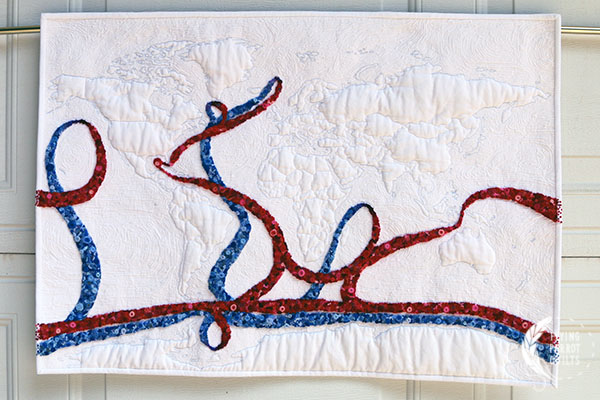
Thousand Year Journey: Ocean Circulation
Where we last left the project, I’d finished the embroidery. My plan for the quilting was for it to be all texture, so I used two battings with wool on top and a Hobbs cotton/poly blend on the bottom. I outlined the land masses/countries with white Glide thread. The filler design in the oceans is quilted with 100-weight Superior MicroQuilter and reflects the ocean surface currents.
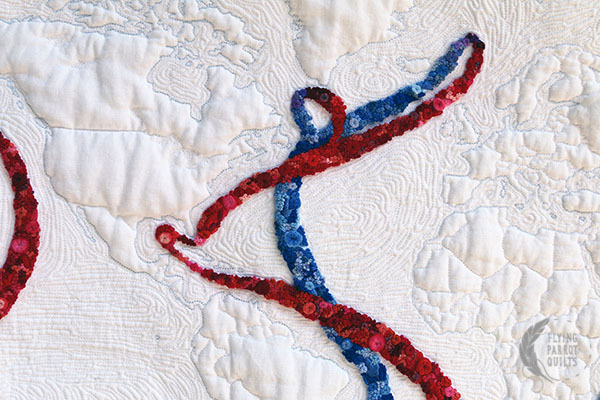
Unfortunately, because countries vary just a tad in size, the continents ended up not standing out very well where countries were small or very skinny, so I decided to go back over all the coastlines with a light bluish-gray thread, and I think that works a lot better.
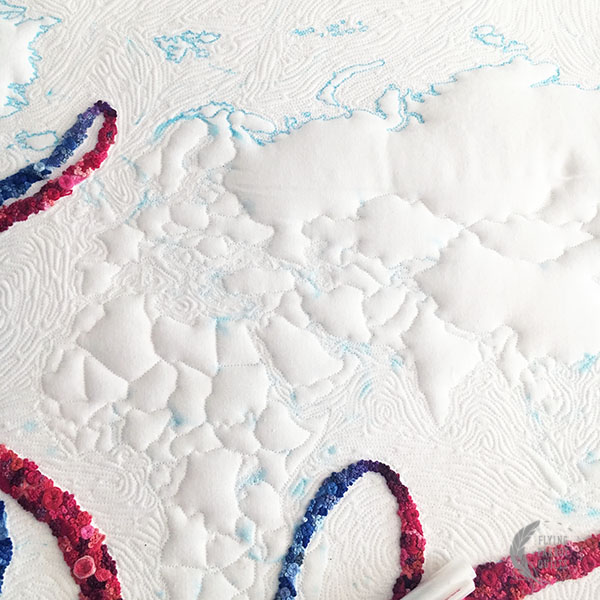
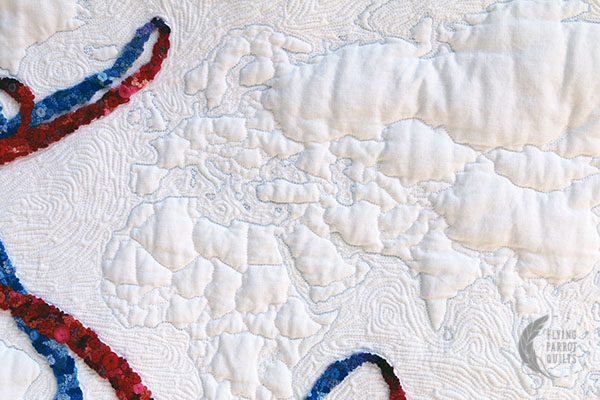
So, some quick awards to various countries based on the ease of quilting them:
- Perfect size and shape: Mongolia
- Most stops and starts: Canada (specifically, the Arctic archipelago!)
- Too many small countries: Southern Europe
- Excessively narrow countries: Southeast Asia
- My sincerest apologies to: All the Polynesian islands. Spare a thought for them; unfortunately, it just wasn’t realistic to try and include any but the very biggest; even Hawaii was a stretch.
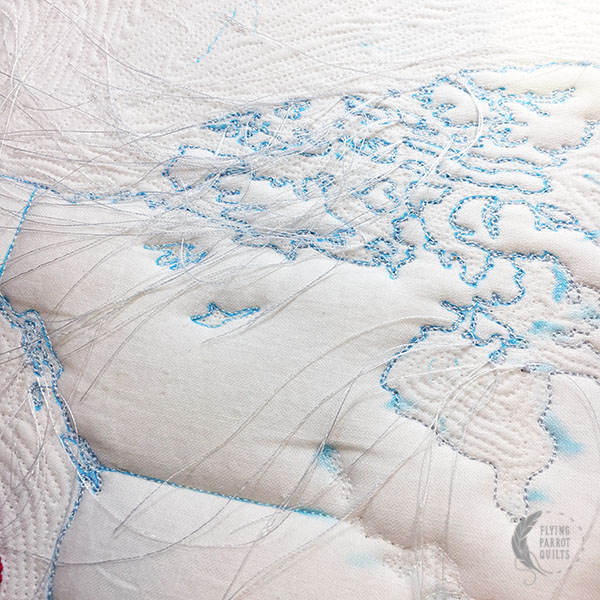
Seriously, Canada. How many frozen islands do you need?
You’ll notice that the texture is different in the photos that have blue markings on them. Rinsing the quilt to get all the blue markings out changed that texture, which was a little disappointing, and I wish there had been a solution to avoid that, but there was just so much blue it wasn’t going to come out with spritzing. Incidentally, the initial rinse caused some of the red threads to bleed, so I had to use hot tap water and blue Dawn soap to get it out (if anyone’s wondering, wool batting handles that fine without shrinkage).
I struggled a little on what to do with Russia and Antarctica—they’re very large un-quilted areas, and as I’m sure most of you know, any flat map of a round planet distorts the size and shape of countries and makes areas closer to the poles appear larger than they are. Unfortunately, adding mountain ranges or other physical features in the quilting would have made it more confusing, so in the end I decided that this was an instance of “you have to know the rules to break them” and it was a deliberate artistic choice to not quilt all areas equally. I did chop off as much of Antarctica as I could to minimize the effect at the bottom of the quilt, but unfortunately, that’s a pretty important area as far as the circulation is concerned.
A digression for cartography nerds: This is a Miller cylindrical projection which is a little better than Mercator in terms of distortion near the pole. Since the quilt is focused on the oceans, it was really hard to find a good projection, and I felt that a rectangular format was going to work best to make it recognizable as a world map. This compromises by cutting the Pacific in half, but cutting continents in half is even stranger, and in any case, the Atlantic is the most interesting part of the circulation and this keeps it front and center.
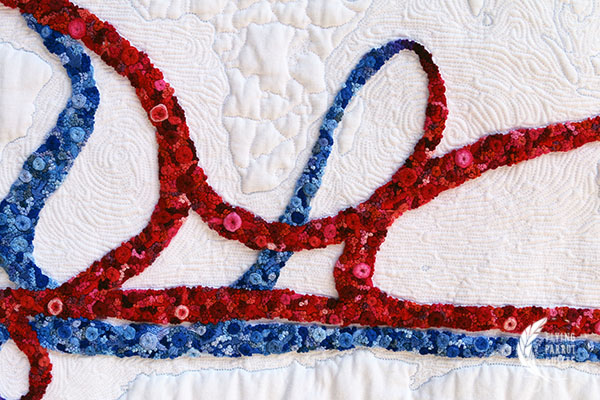
I tried to “fade out” the embroidery in the binding so it wasn’t such a sharp contrast. I actually had some trouble matching the binding to the quilt—the first one I put on was a jarringly different shade of white. On the second try, I think I got the right fabric, although it still looks just a hair different, most likely because the creamier wool batting is changing the color of the rest of the white fabric a little.
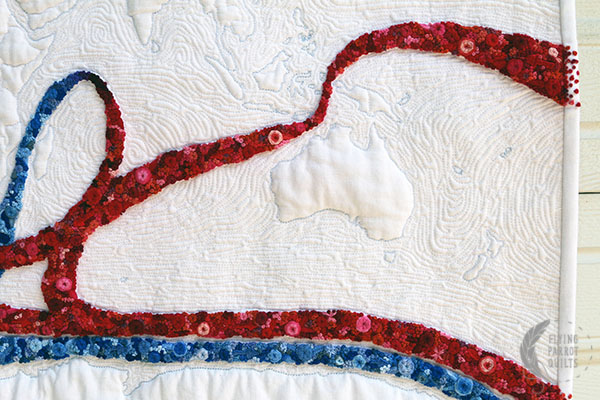
When I posted a sneak peek of Australia a while back, one of my lovely followers got very worried about whether or not New Zealand made it onto the map. Apparently, New Zealand gets left off maps a lot. But not to worry, it’s there!
It was an interesting challenge to make a quilt over which I essentially had no design control; the only things I could choose were textures and how to handle the background world map. This quilt will be in the wall hanging category at the Pacific International Quilt Festival in a few weeks (please share a photo if you’re there!), and it will be interesting to see how the judges feel about it since I have to hope that they will figure out that it’s some sort of map of ocean currents and that where they go isn’t something I could adjust, and that they’ll understand why I left large areas unquilted.
I’m linking this quilt up with the Bloggers’ Quilt Festival—head on over for lots more eye candy!
Quilt Stats:
Size: 29.5″ x 20.5″
Fabric: white solid
Backing: Timeless Treasures white shell print
Batting: Hobbs 80/20 + Quilters Dream Wool
Thread: Continents – Glide 40wt in White and Mercury; Superior Microquilter 100wt
106,654 stitches at 15 spy
Approximate embroidery time: 130 hours
Approximate quilting time: 25 hours
Approximate total time conception to finish: 175 hours


I’m breathless looking at the final product!
Wow. Just wow!!!! 🙂
I’ve seen that map where the Pacific Ocean is in one piece. It is… unsettling- just NOT what we are used to seeing…
This is truly a magnificent piece. I hope to see it in person some day.
I can’t wait to see what you come up with next.
This quilt is so cool. I love the information you provided about the currents. It looks like the 2 currents off the eastern north american continents are waltzing with their arms out. haha love it.
Love this! The artistry is exquisite and I absolutely love the scientific tidbits you’ve included.
Ta-done, and ta-da! This looks wonderful and I would love to see it in person to run my hands over it. Of course I wouldn’t but I bet this feels wonderful.
I like and appreciate your thought too about using a non-commercially standard projection. I’ve been reading a bit about those and find it fascinating.
Lastly, as a Canadian, we need LOTS of islands. Especially Hans Island. After all, we are the “true north!”
Wow what an incredible project! Superb!
Beautiful handwork and quilting! Just lovely!
Wonderful quilt….congratulations!!! I bet you cried when you saw the thread bleeding but am glad that you were able to take care of it. I have a bottle of Blue Dawn on my shelf just for this scenario.
This is fantastic, all the hard work is evident! Sorry I am too late to help on this project, but pick up an Air Soluble marker. It used to be called The Fine Line Air Soluble or Air Erasable, but I think Dritz distributes it now. It has never — never — failed to disappear on cotton. The main problem is that it disappears too fast and you can only trace so far ahead at a time.
I was amazed at the quilt, and then discovered it’s small size … outstanding!
I wish for an iron out marker to use on lighter fabrics like the Clover marker I use for darker fabric, but I just haven’t found anything yet. I think this is stunning, Sylvia! About how large did it finish?
This is such an interesting quilt, fascinating idea. Love how it turned out!
Wow! Really wow! AHIQ has a map challenge going and I have too many ideas but nothing, not one thing, that would even dream of this. It’s just too amazing. I’m thrilled that you’re sharing beauty with the rest of us. I look forward to seeing it in person.
Mary from Fleur de Lis Quilts
Visiting from the Blogger’s Quilt Festival
I have recently “gifted quilts to 2 of my cousins who are both battling breast cancer at this time. We don”t see each other often maybe once a year or less. Both were so overwhelmed and touched by this gift. It was amazing to me their gratitude as I make quilts for the enjoyment of working with fabric and am so pleased when people actually want them. I do keep a few throw/lap quilts on hand for just this reason. I love to see others enjoy my quilts but do always worry that the quilts may not be to their liking.
Totally awesome! You did an amazing job of bringing your inspiration to life, and it is gorgeous, too!
Since I studied Oceanography, I get it! I also enjoy your unique take on this fiber art.
There are so many things I love about this quilt. I have toyed with the idea of using two battings and see how beautiful yours turned out. I may need to do that on my next quilt. When I first saw the quilt from a distant picture, it reminded me of the ribbons from the gymnasts doing the ribbon dances. Thanks for sharing.
Science! With science so under attack lately, it’s a joy to see your quilt so proudly state–“this is based on fact” 🙂 And you quilt is jaw dropping. Thank you!!
WOW It’s fabulous!
This is amazing. I’m having trouble putting my feelings in words. I guess I’ll just stick to amazing! Thanks for sharing.
Such an incredible topic for a quilt and a very tricky one indeed. Your work is just stunning.
This is amazing. It’s beautiful. The texture! The details! Wow! Thanks for sharing!
I love this so much that I have been waiting more than a week to comment because I didn’t have the words to adequately express just how amazing I think this is. I still don’t, but I wanted you to know that this is seriously one of the most striking works in cloth I have ever seen. Everything about it is just so brilliantly thought out and executed. Absolutely stunning work!
This work is so interesting and beautiful–what a labor of love. Congratulations!
Sylvia,
I am so delighted to have discovered you! I also was in marine sciences and am a quilter. Your work is inspiring and you explain “how to” so others can try something new. My husband is a hydrologist and loves your thermocline map. Thanks for demonstrating that science and creativity are related!
Carolyn
P.S. Our last name is Parrott!